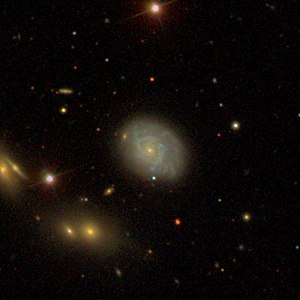NGC 2684
| Galaxy NGC 2684 |
|
|---|---|

|
|
| SDSS recording | |
| AladinLite | |
| Constellation | Big Bear |
|
Position equinox : J2000.0 , epoch : J2000.0 |
|
| Right ascension | 08 h 54 m 54.0 s |
| declination | + 49 ° 09 ′ 37 ″ |
| Appearance | |
| Morphological type | Sc |
| Brightness (visual) | 13.1 mag |
| Brightness (B-band) | 13.8 mag |
| Angular expansion | 0.9 ′ × 0.7 ′ |
| Position angle | 27 ° |
| Surface brightness | 12.4 mag / arcmin² |
| Physical data | |
| Redshift | 0.009540 +/- 0.000033 |
| Radial velocity | 2860 +/- 10 km / s |
|
Stroke distance v rad / H 0 |
(129 ± 9) · 10 6 ly (39.6 ± 2.8) Mpc |
| history | |
| discovery | Wilhelm Herschel |
| Discovery date | March 9, 1788 |
| Catalog names | |
| NGC 2684 • UGC 4662 • PGC 25024 • CGCG 237-024 • MCG + 08-16-035 • IRAS 8514 + 4921 • 2MASX J08545405 + 4909375 • VV 765 • GC 1714 • H III 712 • h 533 • LDCE 0588 NED004 | |
NGC 2684 is a spiral galaxy of Hubble type Sc in the constellation Ursa Major . It is an estimated 129 million light years away from the Milky Way and has a diameter of around 35,000 ly.
In the same area of the sky are the galaxies NGC 2686 , NGC 2687 and NGC 2688 .
The object was discovered by Wilhelm Herschel on March 9, 1788 .
